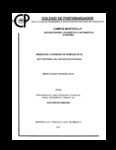| dc.contributor.author | Esparza Vela, Mario Edgar | es |
| dc.creator | ESPARZA VELA, MARIO EDGAR; 39658 | |
| dc.date.accessioned | 2012-09-08T20:46:31Z | |
| dc.date.available | 2012-09-08T20:46:31Z | |
| dc.date.issued | 2007 | es |
| dc.identifier.uri | http://hdl.handle.net/10521/1493 | |
| dc.description | Tesis (Doctorado en Ciencias, especialista en Economía).- Colegio de Postgraduados, 2007. | es |
| dc.description.abstract | El presente documento analiza la socioeconomía de la migración rural en el estado de Durango,
enfatizando en los aspectos de recepción y asignación productiva de las remesas. Uno de los
objetivos de la investigación fue conocer las características del migrante y de la unidad de
producción familiar, que permitieran la definición de las variables significativas, sobre las que
puede incidir la política económica para reorientar o fortalecer el uso productivo de las remesas.
Se construyó un índice que muestra el potencial de inversión productiva, según el cual dicho
potencial existe en 13 de los municipios del estado.
La investigación muestra que la población migrante del estado inicia su vida migratoria en una
edad joven (22 años), es principalmente del sexo masculino (72%) y con una educación básica
de 7 años en promedio. Los migrantes tienen como destinos principales los estados de Texas
(24%), Colorado (23%), California (19%) y Nevada (10%). Datos de campo indican que la
familia del migrante tiene un ingreso promedio anual de 3,580 dólares. La mayor parte (94%) de
las remesas recibidas se asigna para gastos del hogar y el restante 6% es utilizado en bienes de
consumo duradero, en ahorro o en inversiones, como son mejoras en la vivienda o inversión
productiva.
La inversión de remesas en la economía rural del estado de Durango se presentó en el 5% de la
muestra estudiada. Existen variables económicas que influyen en el comportamiento y la
capacidad de invertir, como son: a) la diversificación del ingreso familiar; b) el nivel de
bienestar de la familia; c) el conocimiento previo de la actividad económica en donde se invierte
y la disponibilidad de mano de obra; d) el ingreso, la actividad que desempeña y el status legal
del migrante y e) el acceso a créditos para la producción y a la capacitación empresarial._______The present document analyzes the socio-economic of the rural migration in the state of
Durango, emphasizing in the aspects of reception and productive allocation of the remittances.
One of the objectives of the investigation was to know the characteristics the emigrant and the
unit of familiar production, that allowed the definition of the significant variables, which the
economic policy can affect to reorient or to fortify the productive use of the remittances. An
index was constructed that shows the potential of productive investment, according to which
potential saying exists in 13 of the municipalities of the state.
The investigation sample that the emigrant population of the state initiates its migratory life in a
young age (22 years), is mainly of masculine sex (72%) and with a basic education of 7 years in
average. The emigrants have like main destinies the states of Texas (24%), Colorado (23%),
California (19%) and Snow-covered (10%). Data of field indicate that the family of the emigrant
has an entrance annual average of 3.580 dollars. Most (94%) of the received remittances is
assigned for expenses of the home and rest 6% is used in lasting consumer goods, saving or
investments, as they are improvements in the house or productive investment.
The investment of remittances in the rural economy of the state of Durango appeared in 5% of
the studied sample. They exist variable economic that influences in the behavior and the
capacity to invest, as they are: a) the diversification of the familiar entrance; b) the level of well-
being of the family; c) the previous knowledge of the economic activity in where it is reversed
and the availability of manual labor; d) the entrance, the activity that carry out and the legal
status of emigrant and e) the access on credits for the production and the enterprise qualification. | es |
| dc.language.iso | spa | es |
| dc.rights.uri | http://creativecommons.org/licenses/by-nc-nd/4.0 | |
| dc.subject | Migración | es |
| dc.subject | Remesas | es |
| dc.subject | Inversión | es |
| dc.subject | Durango | es |
| dc.subject | Sector Rural | es |
| dc.subject.ddc | Doctorado | |
| dc.subject.ddc | Economía | |
| dc.title | Migración e inversión de remesas en el sector rural del estado de Durango | es |
| dc.type | Tesis | es |
| Tesis.contributor.advisor | Santiago Cruz, María de Jesús | |
| Tesis.contributor.advisor | Velázquez Hernández, María de los Angeles | |
| Tesis.contributor.advisor | Nava Tablada, Martha Elena | |
| Tesis.contributor.advisor | Salas González, José María | |
| Tesis.contributor.advisor | García Salazar, José Alberto | |
| Tesis.subject.nal | Migración rural-urbana - Durango (México). | |
| Tesis.subject.nal | Inversiones - Durango (México). | |
| Tesis.subject.nal | Sector agrario - Durango (México). | |
| Tesis.subject.nal | Desarrollo rural - Durango (México). | |
| Tesis.subject.nal | Sociología - Durango (México). | |
| dc.subject.ingles | Migration | es |
| dc.subject.ingles | Remittances | es |
| dc.subject.ingles | Investment | es |
| dc.subject.ingles | Rural Sector | es |
| dc.type.conacyt | doctoralThesis | |
| dc.identificator | 5 | |
| dc.contributor.director | SANTIAGO CRUZ, MARIA DE JESUS LEONIDES; 395 | |


